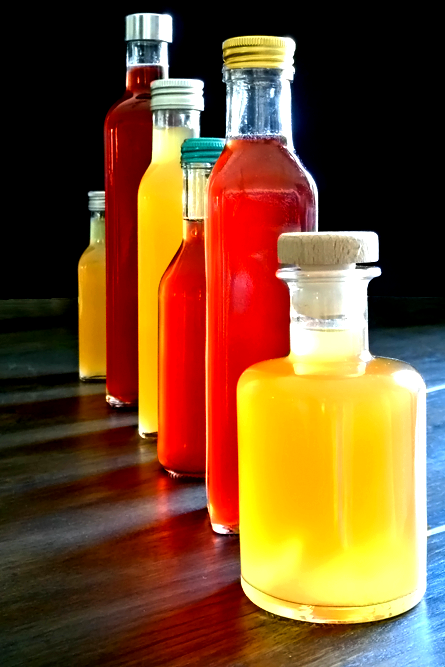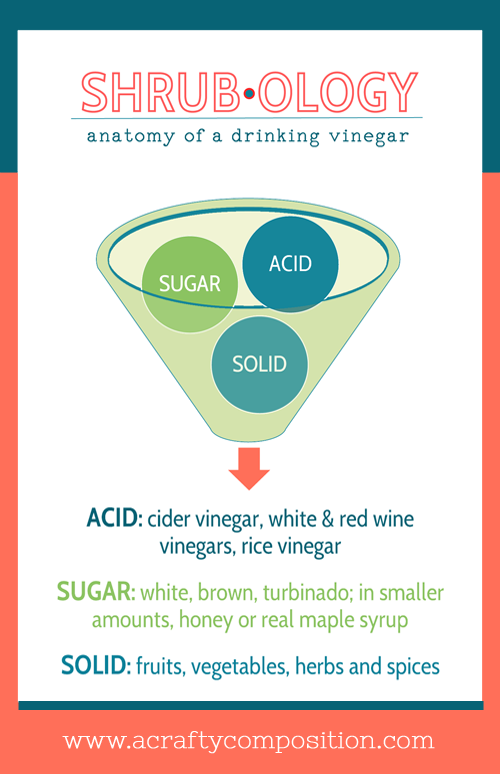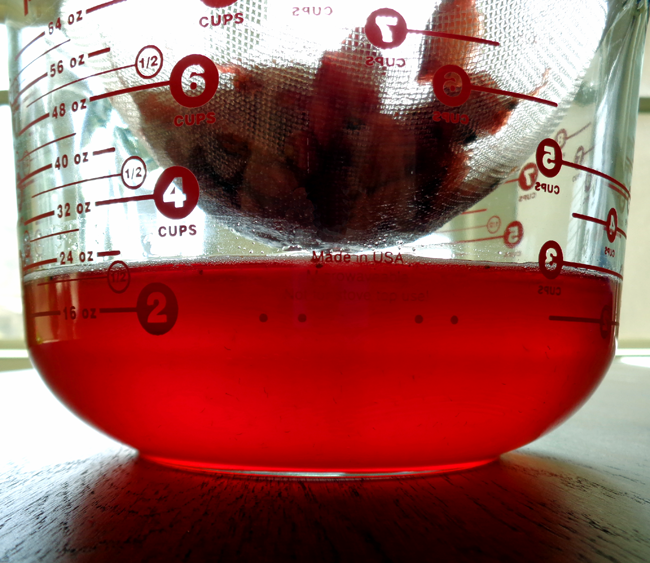
With the temperatures rising across the country it is time to talk about the perfect summer sipper: The Shrub. Shrubs, or drinking vinegars as they are sometimes called, are a mixture of sugar, fruit or vegetable and an acid, usually vinegar. They are delightfully tangy, very refreshing and equally delicious in alcohol-free beverages or cocktails. Additionally, they are incredibly easy and enjoyable to make with endless flavor combinations to explore. Are you ready for a new favorite summer drink? Let’s get started.
A Quick History of the Shrub
Shrubs are not a new invention. In fact, the first literary reference to the shrub was in 1747 in London’s Gentlemen’s Magazine. While the original 18th century English versions involved the use of brandy or rum, the American colonial shrubs were often a by-product of vinegar preserved fruits. Once the fruit was removed, sugar or honey was added to the remaining vinegar which was then reduced to create a sweet-tart syrup, ready to be added to water or cocktails. When refrigeration became widely available, preserving fruits and vegetable in vinegar was not necessary and the shrub was all but forgotten for several decades. Thankfully, everything eventually becomes new again and the shrub has returned as a valued ingredient in the artisan cocktail movement.

Shrubbery 101
(No, not for the Knights who say Ni)
One of the wonderful things about shrubs is there are hundreds of possible flavor combinations. A shrub is made up of three main components: an acid (vinegar), a sugar and a solid (fruit/vegetable/herb). Generally speaking, these components are in equal proportions; for example, one cup of each. Sometimes, with a solid that is mild in flavor or tough (like rhubarb), you will start with about twice as much solid.

Two Methods of Shrub Making
There are two methods of creating the shrub syrup; the cold method and the cooking method. The method you use really depends on your personal preference, the type of fruit or veggie being used and your level of patience.
Cold Method
The cold method of shrub making is preferred by many as it tends to create more complex flavors. Stone fruits, berries, soft vegetables and herbs work really well with the cold method because they are easily broken down without heat. This method is typically done over several days, allowing time for all the flavors to blend and expand.
First, cut up your washed fruit/veggies/herbs into bite size pieces. Place them in a bowl, stir in the sugar and let sit for 24 to 48 hours. I like to cover my bowl with a dish towel and let it sit at room temperature for 3 or 4 hours to really get the process going. Then I move the bowl into the fridge for the remaining time, giving it a stir a few times through the process.


During this ‘maceration’ period, the sugar draws out the delicious juices from the fruit or vegetable and you are left with a nice chunky syrup.
Use a strainer (with cheese cloth or coffee filter for extra straining) to separate the juice from the solids. Dispose of the solids.

Now add your acid (vinegar) of choice. Remember the 1:1:1 ratio. If you used 1 cup of sugar you will use about 1 cup of acid. You can always tweak the formula to taste, adding a bit more sugar or vinegar to get the flavor you desire. Pour your shrub syrup into a clean glass jar or bottle and place it in the fridge. Let it sit there for 3 or 4 days, giving it a good shake a few times each day. Now you have a wonderfully tangy-sweet shrub from which you can make a variety of sodas, waters and cocktails. The shrub can last up to 2 months in the fridge.
Cooking Method
The cooking method of shrub making is great for tougher, more fibrous fruits and vegetables or when you don’t have time to wait for natural maceration to occur. I especially like this method for rhubarb. In this method, you follow the same steps as in the cold method except, you will cook your fruit/veggie and sugar to force the release of it’s juices. Some recipes say to add the vinegar before you cook it. Others say to add some water to the fruit/veggie and sugar mixture, cook it and THEN add the vinegar. I’ve done it both ways and, without knowing all the science behind it, I feel cooking it with the vinegar creates a stronger flavor and a slightly thicker syrup.
I have a fun little video of the cooking method of shrub making on my YouTube Channel HERE.

Developing Fantastic Flavor Combinations
Last week I shared my favorite tool in the kitchen, The Flavor Bible. Once you have the simple steps of shrub making down, you can use this book to create amazing flavor combinations.

The Flavor Bible is the perfect guide to help you decide which acids, sugars and solids go best together. After you’ve made your shrub syrup, The Flavor Bible can help you chose secondary and complimentary flavors to create uniquely delicious sodas & cocktails. Remember, shrub syrups are very concentrated. You only need about .75 to 1 oz of shrub syrup per drink.
Here are just a few of my favorite flavor combinations. All of these beverages are equally delicious without alcohol; just omit the booze and add ginger ale, flavored sparkling water, club soda or mineral water.
Shrub Ingredients: Strawberries, Black Peppercorn, White Sugar, Red Wine Vinegar
Drink: .75 oz Shrub syrup, 2 oz Gin or Vodka, Fresh Squeezed Lime Juice, top with Ginger Beer
Shrub Ingredients: Blackberries, Lemon Zest, Ginger, Brown Sugar, White Wine Vinegar
Drink: .75 oz Shrub syrup, 2 oz Citron Vodka, top with Club Soda, add a Sprig of Fresh Mint or Thyme
Shrub Ingredients: Raspberries, Rhubarb, Lemon Zest, Brown Sugar, White Wine or Cider Vinegar
Drink: .75 oz Shrub syrup, 1.5 oz Vodka or White Rum, 1 oz Cointreau, Juice of 1 Lime, 8-10 Muddled Mint Leaves, top with Club Soda
I hope you enjoyed learning how to make and use shrubs. My son makes a parsley & celery shrub that I am very curious to try. I’ll let you know how it goes. Please feel free to share your opinions, experiences and favorite flavor combinations in the comment section below. Don’t be shy… seeing comments in my in-box makes me do the happy dance!
Did you know you can SUBSCRIBE to this blog so that you don’t miss any of it’s crafty goodness?! You can subscribe at the same time you make your comment below or just go to the ‘Don’t Miss a Thing’ section on the top -right of any page on the blog. Your email information is never shown or shared.
Sharing is caring!
Related Posts
Christmas Breakfast: How to feed the family without missing the fun
Christmas morning is always magical; twinkling lights, jingling music, wrapping paper covering the floor. There…
December 17Very Cherry Plum Galette
I was zipping through the grocery store the other day when I came across the…
August 14 COMMENTS
COMMENTS (I love hearing from you!)
This site uses Akismet to reduce spam. Learn how your comment data is processed.






Maria Conti | 13th May 18
Thank the for all this goodness! Will have to try making some😋
JoElle | 18th May 18
You are very welcome, Maria. I think you would enjoy them as, with or without alcohol, they are so refreshing.
Vikki | 11th May 18
Your video makes that shrub look delicious! I like the combinations you suggest and it seems a simple–and yummy–thing to make. Ni, Ni !!
JoElle | 11th May 18
Thank you Vikki. It seems I just can NOT say ‘shrubbery’ without thinking of the Knights Who Say Ni. Tee he he (or is it Ni Ni Ni)